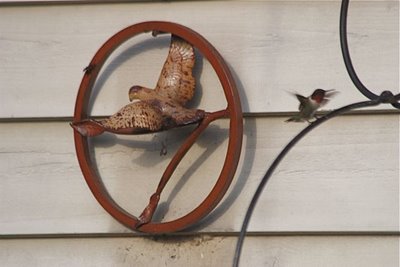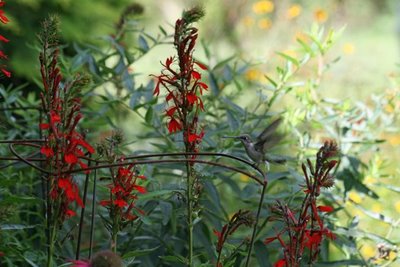
It had to happen, sooner or later. The hummingbirds are leaving us. I had been running two "World's Largest" Perky Pet feeders, which hold about a gallon apiece. I was making nectar about every three days, which tells you that I had a whole mess o' hummers here, maybe 10 or 15 at one time. By the timeworn formula, multiplying the number I could count times six, I had from 60-90 birds using my feeder. But they all started to depart on August 22, and I'm down to one feeder, and I fill it about 1/10 full...sigh. I already miss the humming masses.
While the hummer numbers were at their height, I took a lawnchair out to the cardinalflower beds one sunny morning, and fired away. The beds were in shade, with bright sunny background behind, so there was bounce light, but nothing direct. I liked the moody result--different from most hummingbird photos, which tend to be bathed in sun or (worse) flash strobe. Blaaa. I think a hummingbird's wings should blur, because that's how we see them in real life.
But I played with exposures and ISO and managed to freeze the bird's wings for one shot:
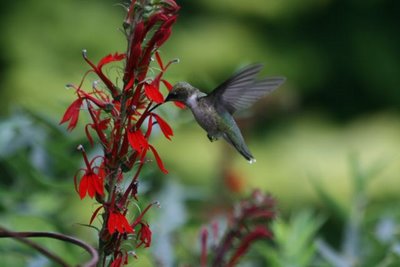
and then I relaxed and let them blur as they should. This is a young male, evidenced by his heavy throat streaking. Catch those green streaks in sunlight, and you may see a ruby glinting at you.
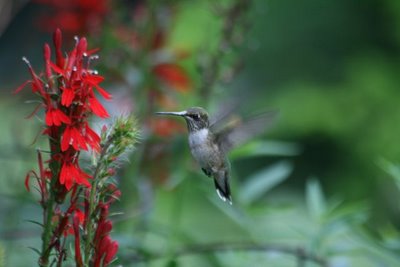
I absolutely love this shot, of a bird feeding from my bee balm:
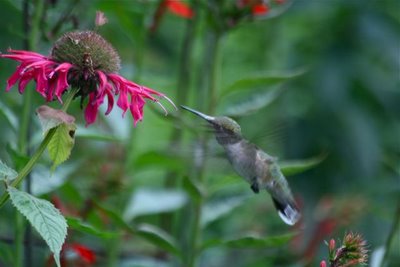
It's a gauzy fairy, suspended in air as if by magic. I was mercilessly baking my bee balm in a full-sun bed when I conferred with my garden landscaping friend Tim, oracle of all things planty. "You're cooking it. That's why its leaves turn yellow in mid-summer." So I dug it all up and put it in the north-facing moist cardinalflower bed in the shade of my heirloom lilac. It's the first time I've ever transplanted anything and not had it wilt. It was as if the bee balm had come home at last. I can't wait until next year. It ought to come roaring back. Monarda is a top fab fave of hummingbirds.
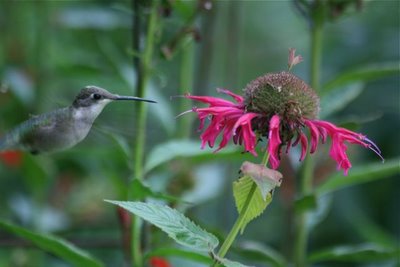
A lot of people are surprised to find that ruby-throats like to perch rather than hover when they're feeding. You have to hang around and watch them for awhile to get that simple truth.
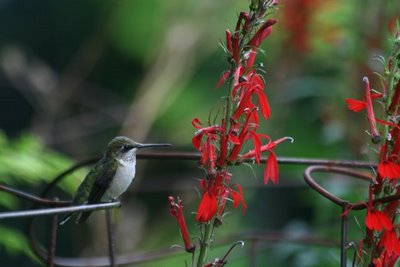
Would you run in place while eating if you had a choice to run or sit down? Would you stand at the sink and gobble something down if there were a table and chair nearby? (Mothers are disqualified from answering). No, a normal person wouldn't, and neither would a hummingbird. Witness this:
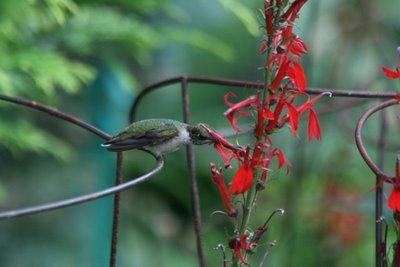
and this:
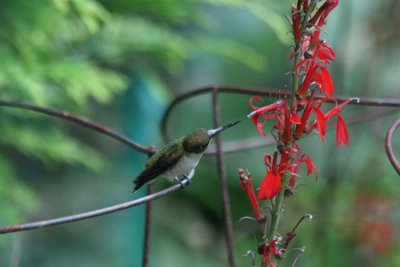
See the white cardinalflower pollen on his snoot? He's been making seeds for the plants.
I keep these little wire cages around my cardinalflower, even though they're pretty much self-supporting, because the hummers love to perch on them. They're great for watching for rivals
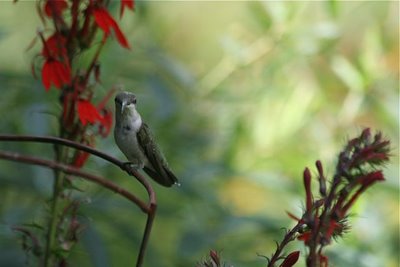
below and above.
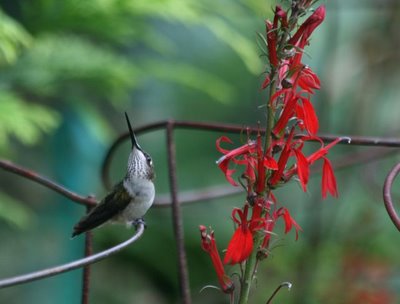
The
Lobelia cardinalis that I've got here are all seed children from a couple of plants from Land Reformers Nursery here in southern Ohio. They specialize in Ohio-grown native plants. I've bought lots of cardinalflower over the years, but the only ones that have survived and prospered and made babies are the native ones from Land Reformers. Hint: When they go to seed and the capsules ripen, I break them off and lay them where I want more cardinalflower. Keep them watered and the soil open, and you should have more next year. They bloom in their second year of life. What a marvelous plant.
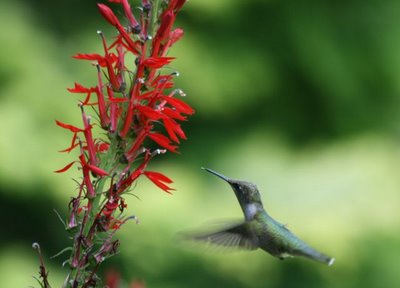
They are beautiful, and they attract the beautiful, and they bloom when everything else (of a cultivated sort) is gasping its last in the garden, when all the wildflowers go crazy in the meadows and streambanks.
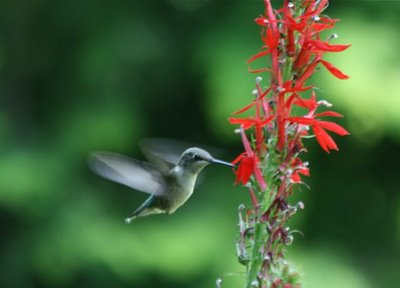
Ahh, the gift of hummingbirds and cardinalflower. I savor them while I may.
Labels: bee balm, cardinalflower, Lobelia cardinalis, monarda fistulosa, native plants for hummingbirds, ruby-throated hummingbirds

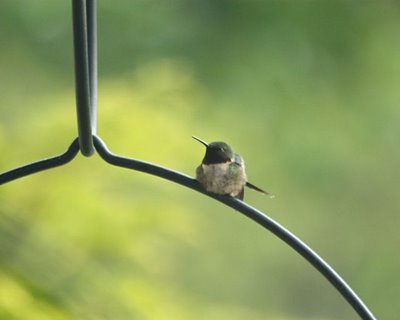
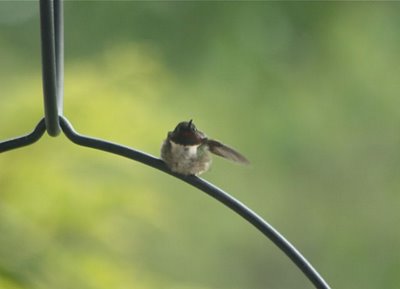
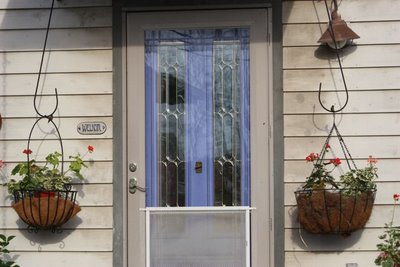
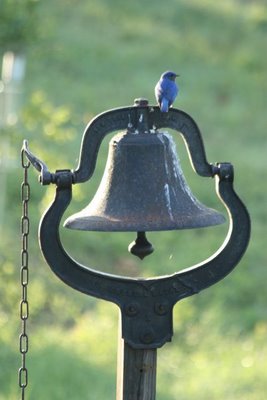
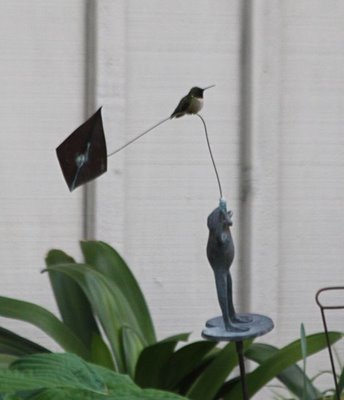 For sheer serendipity, though, I have to hand it to this shot of life imitating the Garden Forge art made by our friends Betsy and Jan.
For sheer serendipity, though, I have to hand it to this shot of life imitating the Garden Forge art made by our friends Betsy and Jan.